Multi-Scale Analysis of Green Space for Human Settlement Sustainability in Urban Areas of the Inner Mongolia Plateau, China
Abstract
:1. Introduction
2. Materials and Methods
2.1. Study Area
2.2. Data Source
2.3. Extraction of Differential Characteristics of Intra-Urban Green Space
2.3.1. Boundary Inspection and Quality Cor Rection
2.3.2. Extraction of Urban/Park Green Space
Remote Sensing Image Download and Pre-Processing
Extraction of Green Space Fractions
Extraction of Park Green Space
2.3.3. Accuracy Assessment of Green Space
3. Results
3.1. Results for Accuracy Assessment
3.2. Spatial Characteristics of Urban Size and Distribution
3.3. Analysis of Urban Green Space
3.3.1. Analysis of Intra-Urban Green Space Fractions
3.3.2. Analysis of Park Green Space
3.4. Analysis of the Ecological Service of Urban Green Space and Park Green Space
4. Discussion
4.1. Improving the Quality of Residential Green Space in the Inner Mongolia Plateau of China
4.2. Difference in Spatial Configuration between Park Green Space and Residential Area
4.3. Positive Effect of Green Space on Human Settlement Environment in the Inner Mongolia Plateau
5. Conclusions
Author Contributions
Funding
Conflicts of Interest
References
- Grimm, N.B.; Faeth, S.H.; Golubiewski, N.E.; Redman, C.L.; Wu, J.; Bai, X.; Briggs, J.M. Global change and the ecology of cities. Science 2008, 319, 756–760. [Google Scholar] [CrossRef] [PubMed] [Green Version]
- Georgescu, M.; Morefield, P.E.; Bierwagen, B.G.; Weaver, C.P. Urban adaptation can roll back warming of emerging megapolitan regions. Proc. Natl. Acad. Sci. USA 2014, 111, 2909–2914. [Google Scholar] [CrossRef] [PubMed] [Green Version]
- Rodriguez, R.S.; Ürge-Vorsatz, D.; Barau, A.S. Sustainable development goals and climate change adaptation in cities. Nat. Clim. Change 2018, 8, 181–183. [Google Scholar] [CrossRef]
- Liverman, D.; Rockström, J.; Visbek, M.; Leemans, R.; Abrahamse, T.; Becker, B.; d’Sousa, R.; Jones, K.; Mooney, H.; Niang, I. Future Earth Initial Design; ICSU: Paris, France, 2013. [Google Scholar]
- Feng, G.; Xueyan, Z.; Xiaoyu, S.; Bao, W.; Penglong, W.; Yibo, N.; Weijun, W.; Chunlin, H. Connotation and evaluation index system of beautiful china for sdgs. Adv. Earth Sci. 2019, 34, 295–305. [Google Scholar]
- He, C.; Liu, Z.; Tian, J.; Ma, Q. Urban expansion dynamics and natural habitat loss in china: A multiscale landscape perspective. Glob. Change Biol. 2014, 20, 2886–2902. [Google Scholar] [CrossRef] [PubMed]
- M’Ikiugu, M.M.; Kinoshita, I.; Tashiro, Y. Urban green space analysis and identification of its potential expansion areas. Procedia-Soc. Behav. Sci. 2012, 35, 449–458. [Google Scholar] [CrossRef] [Green Version]
- Hiironen, J.; Mattila, P.; Lääti, M.; Oja, H.; Katajamäki, M.; Tanskanen, H.; Konttinen, K.; Penttilä, L. Renewing the evaluation of land consolidation effects. In Proceedings of the FIG Congress, Sydney, Australia, 11–15 April 2010. [Google Scholar]
- Xu, G.; Dong, T.; Cobbinah, P.B.; Jiao, L.; Sumari, N.S.; Chai, B.; Liu, Y. Urban expansion and form changes across african cities with a global outlook: Spatiotemporal analysis of urban land densities. J. Clean. Prod. 2019, 224, 802–810. [Google Scholar] [CrossRef]
- Li, H.; Ding, L.; Ren, M.; Li, C.; Wang, H. Sponge city construction in china: A survey of the challenges and opportunities. Water 2017, 9, 594. [Google Scholar] [CrossRef] [Green Version]
- Chi, W.; Shi, W.; Kuang, W. Spatio-temporal characteristics of intra-urban land cover in the cities of china and USA from 1978 to 2010. J. Geogr. Sci. 2015, 25, 3–18. [Google Scholar] [CrossRef]
- Chen, J.; Chen, J.; Liao, A.; Cao, X.; Chen, L.; Chen, X.; He, C.; Han, G.; Peng, S.; Lu, M. Global land cover mapping at 30 m resolution: A pok-based operational approach. ISPRS J. Photogramm. Remote Sens. 2015, 103, 7–27. [Google Scholar] [CrossRef] [Green Version]
- Pauleit, S.; Ennos, R.; Golding, Y. Modeling the environmental impacts of urban land use and land cover change—A study in Merseyside, UK. Landsc. Urban. Plan. 2005, 71, 295–310. [Google Scholar] [CrossRef]
- Senetra, A.; Krzywnicka, I.; Mielke, M. An analysis of the spatial distribution, influence and quality of urban green space—A case study of the polish city of tczew. Bull. Geogr. Socio-Econ. Ser. 2018, 42, 129–149. [Google Scholar] [CrossRef] [Green Version]
- Tian, Y.; Jim, C.; Liu, Y. Using a spatial interaction model to assess the accessibility of district parks in Hong Kong. Sustainability 2017, 9, 1924. [Google Scholar] [CrossRef] [Green Version]
- Moreira, T.C.L.; Polizel, J.L.; Santos, I.S.; Filho, D.F.S.; Bensenor, I.; Lotufo, P.A.; Mauad, T. Green spaces, land cover, street trees and hypertension in the megacity of sao paulo. Int. J. Environ. Res. Public Health 2020, 17, 725. Available online: https://www.mdpi.com/1660-4601/17/3/725# (accessed on 19 July 2020). [CrossRef] [PubMed] [Green Version]
- Johnson, M.P. Environmental impacts of urban sprawl: A survey of the literature and proposed research agenda. Environ. Plan. A 2001, 33, 717–735. [Google Scholar] [CrossRef] [Green Version]
- González, M.J.G. Planning, urban sprawl and spatial thinking. Eur. J. Geogr. 2017, 8, 32–43. [Google Scholar]
- Wu, C.; Murray, A.T. Estimating impervious surface distribution by spectral mixture analysis. Remote Sens. Environ. 2003, 84, 493–505. [Google Scholar] [CrossRef]
- Gong, W.; Yuan, L.; Fan, W.; Stott, P. Analysis and simulation of land use spatial pattern in harbin prefecture based on trajectories and cellular automata—Markov modelling. Int. J. Appl. Earth Obs. Geoinf. 2015, 34, 207–216. [Google Scholar] [CrossRef]
- Chen, W.; Huang, H.; Dong, J.; Zhang, Y.; Tian, Y.; Yang, Z. Social functional mapping of urban green space using remote sensing and social sensing data. ISPRS J. Photogramm. Remote Sens. 2018, 146, 436–452. [Google Scholar] [CrossRef]
- Zhonghua, W.; Tianming, Z. In Analysis on the market accessibility of tourism resources based on gis—A case study of Xuzhou city. In Proceedings of the 2010 Second IITA International Conference on Geoscience and Remote Sensing, Qingdao, China, 28–31 August 2010; IEEE: New York, NY, USA, 2010; pp. 80–84. [Google Scholar] [CrossRef]
- Weng, Q.; Lu, D. A sub-pixel analysis of urbanization effect on land surface temperature and its interplay with impervious surface and vegetation coverage in Indianapolis, United States. Int. J. Appl. Earth Obs. Geoinf. 2008, 10, 68–83. [Google Scholar] [CrossRef]
- Li, Z.; Wu, W.; Liu, X.; Fath, B.D.; Sun, H.; Liu, X.; Xiao, X.; Cao, J. Land use/cover change and regional climate change in an arid grassland ecosystem of inner Mongolia, China. Ecol. Model. 2017, 353, 86–94. [Google Scholar] [CrossRef]
- Zhang, Z.; Wang, X.; Zhao, X.; Liu, B.; Yi, L.; Zuo, L.; Wen, Q.; Liu, F.; Xu, J.; Hu, S. A 2010 update of national land use/cover database of china at 1: 100000 scale using medium spatial resolution satellite images. Remote Sens. Environ. 2014, 149, 142–154. [Google Scholar] [CrossRef]
- Liu, J.; Kuang, W.; Zhang, Z.; Xu, X.; Qin, Y.; Ning, J.; Zhou, W.; Zhang, S.; Li, R.; Yan, C. Spatiotemporal characteristics, patterns, and causes of land-use changes in China since the late 1980s. J. Geogr. Sci. 2014, 24, 195–210. [Google Scholar] [CrossRef]
- Hurni, H.; Tato, K.; Zeleke, G. The implications of changes in population, land use, and land management for surface runoff in the upper Nile basin area of Ethiopia. Mt. Res. Dev. 2005, 25, 147–154. [Google Scholar] [CrossRef] [Green Version]
- Lu, D.; Moran, E.; Hetrick, S. Detection of impervious surface change with multitemporal landsat images in an urban–rural frontier. ISPRS J. Photogramm. Remote Sens. 2011, 66, 298–306. [Google Scholar] [CrossRef] [PubMed] [Green Version]
- Tateishi, R.; Shimazaki, Y.; Gunin, P. Spectral and temporal linear mixing model for vegetation classification. Int. J. Remote Sens. 2004, 25, 4203–4218. [Google Scholar] [CrossRef]
- Wu, C. Normalized spectral mixture analysis for monitoring urban composition using etm+ imagery. Remote Sens. Environ. 2004, 93, 480–492. [Google Scholar] [CrossRef]
- Zhang, C.; Chen, Y.; Lu, D. Mapping the land-cover distribution in arid and semiarid urban landscapes with landsat thematic mapper imagery. Int. J. Remote Sens. 2015, 36, 4483–4500. [Google Scholar] [CrossRef]
- Wang, Y.; Huang, F.; Wei, Y. Water body extraction from landsat etm+ image using mndwi and kt transformation. In Proceedings of the 21st International Conference on Geoinformatics, Kaifeng, China, 20–22 June 2013; IEEE: New York, NY, USA, 2013; pp. 1–5. [Google Scholar] [CrossRef]
- Abeje, M.T.; Tsunekawa, A.; Haregeweyn, N.; Nigussie, Z.; Adgo, E.; Ayalew, Z.; Tsubo, M.; Elias, A.; Berihun, D.; Quandt, A. Communities’ livelihood vulnerability to climate variability in Ethiopia. Sustainability 2019, 11, 6302. [Google Scholar] [CrossRef] [Green Version]
- Del Mar Martínez-Bravo, M.; Martínez-del-Río, J.; Antolín-López, R. Trade-offs among urban sustainability, pollution and livability in European cities. J. Clean. Prod. 2019, 224, 651–660. [Google Scholar] [CrossRef]
- Chen, Z.; Lu, M.; Ni, P. Urbanization and rural development in the people’s republic of China. In Cities of Dragons and Elephants: Urbanization and Urban. Development in China and India; ADB Institute: Mandaluyong, Phillipines, 2019; Volume 9. [Google Scholar]
- Zhao, J.; Ouyang, Z.; Zheng, H.; Zhou, W.; Wang, X.; Xu, W.; Ni, Y. Plant species composition in green spaces within the built-up areas of Beijing, China. Plant. Ecol. 2010, 209, 189–204. [Google Scholar] [CrossRef]
- Jiang, Y.; Fu, P.; Weng, Q. Assessing the impacts of urbanization-associated land use/cover change on land surface temperature and surface moisture: A case study in the midwestern United States. Remote Sens. 2015, 7, 4880–4898. [Google Scholar] [CrossRef] [Green Version]
- Sang, Y.-F.; Yang, M. Urban waterlogs control in China: More effective strategies and actions are needed. Nat. Hazards 2017, 85, 1291–1294. [Google Scholar] [CrossRef]
- Wang, C.; Li, Y.; Myint, S.W.; Zhao, Q.; Wentz, E.A. Impacts of spatial clustering of urban land cover on land surface temperature across Köppen climate zones in the contiguous United States. Landsc. Urban Plan. 2019, 192, 103668. [Google Scholar] [CrossRef]
- Lazzarini, M.; Marpu, P.R.; Ghedira, H. Temperature-land cover interactions: The inversion of urban heat island phenomenon in desert city areas. Remote Sens. Environ. 2013, 130, 136–152. [Google Scholar] [CrossRef]
- Milego, R.; Michelet, J.F.; Arévalo, J.; Jupova, K.; Larrea, E. ESPON Fuore: Functional Urban Areas and Regions in Europe; ESPON: Luxembourg, 2019. [Google Scholar]

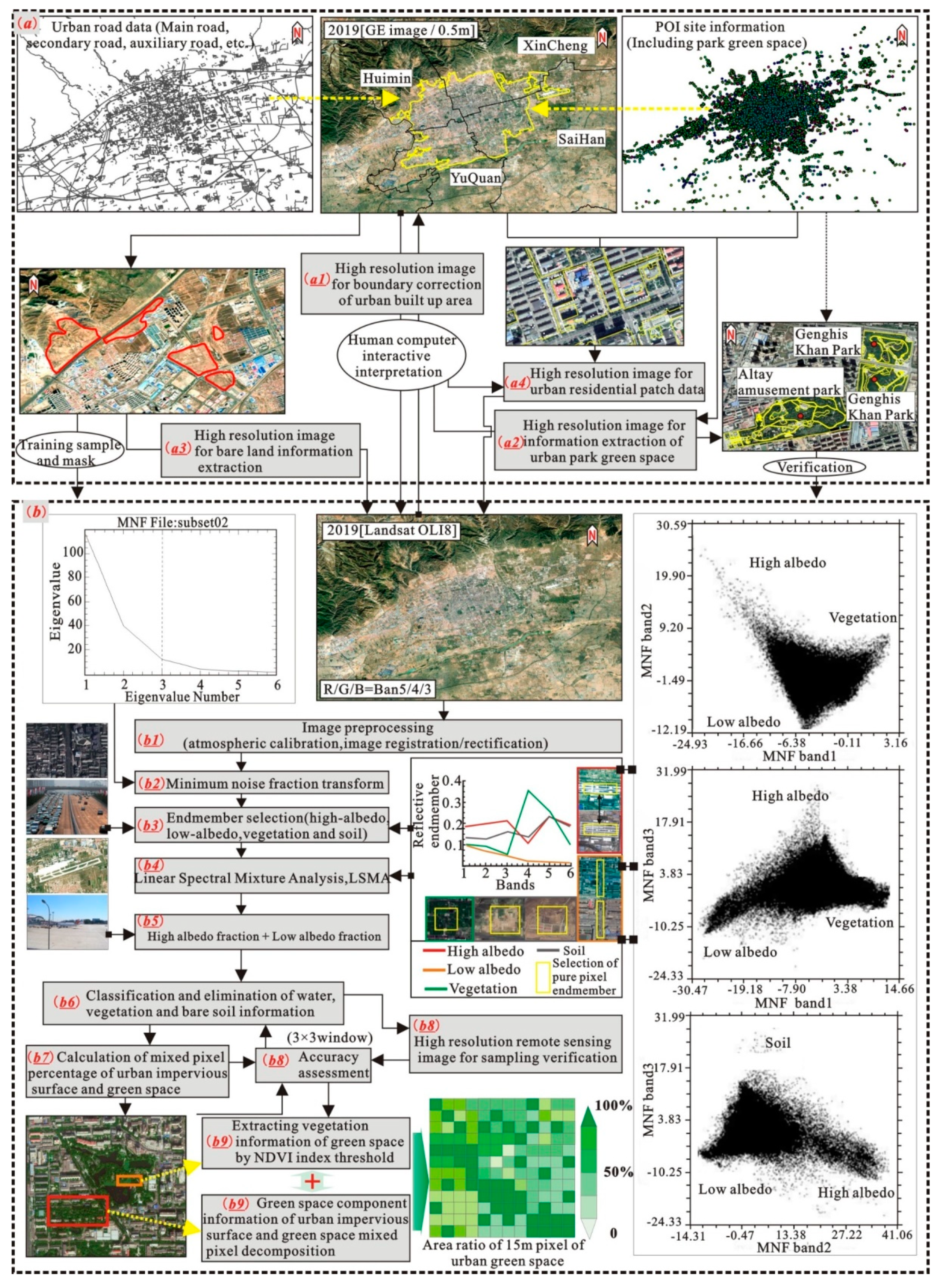
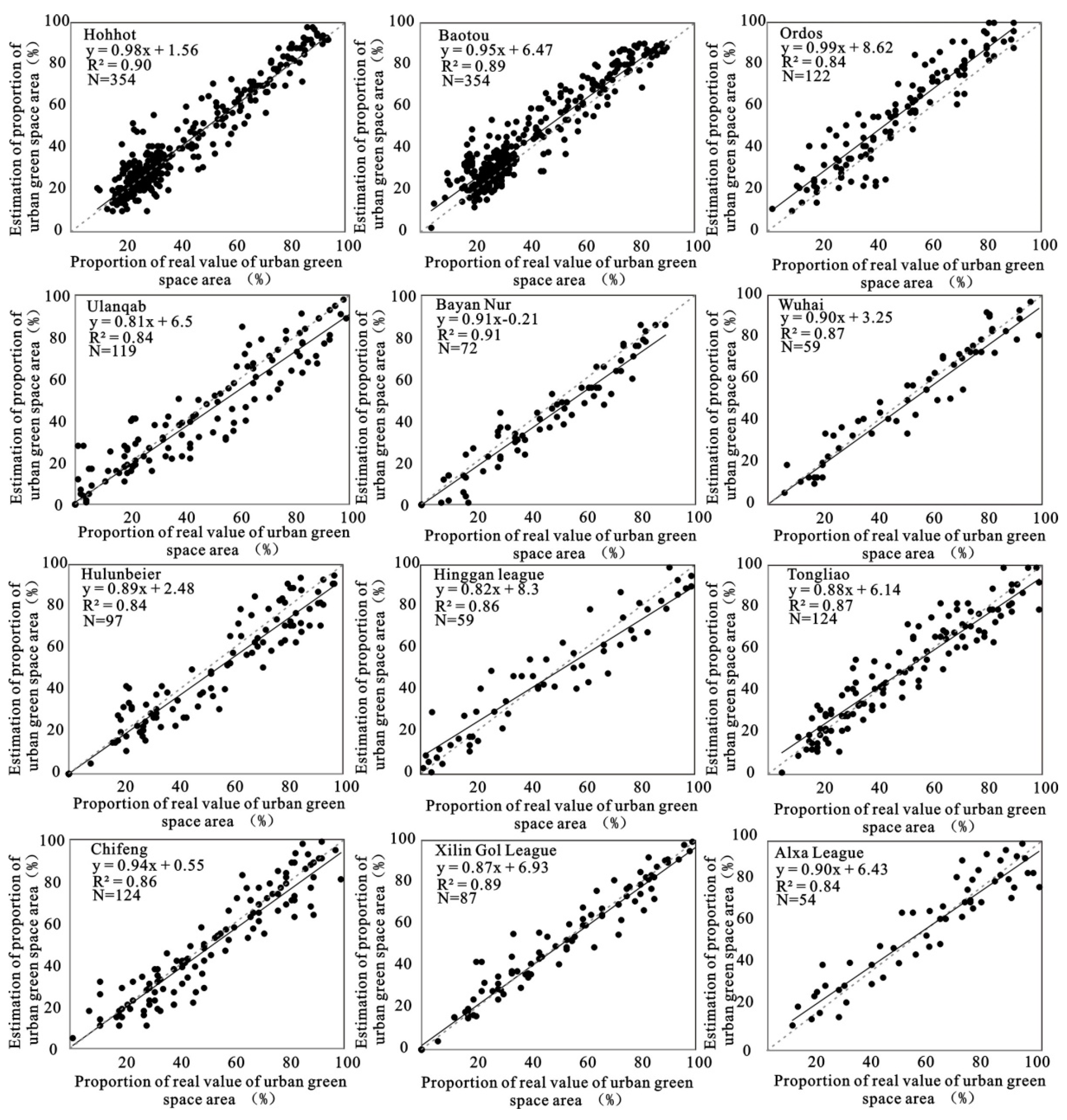
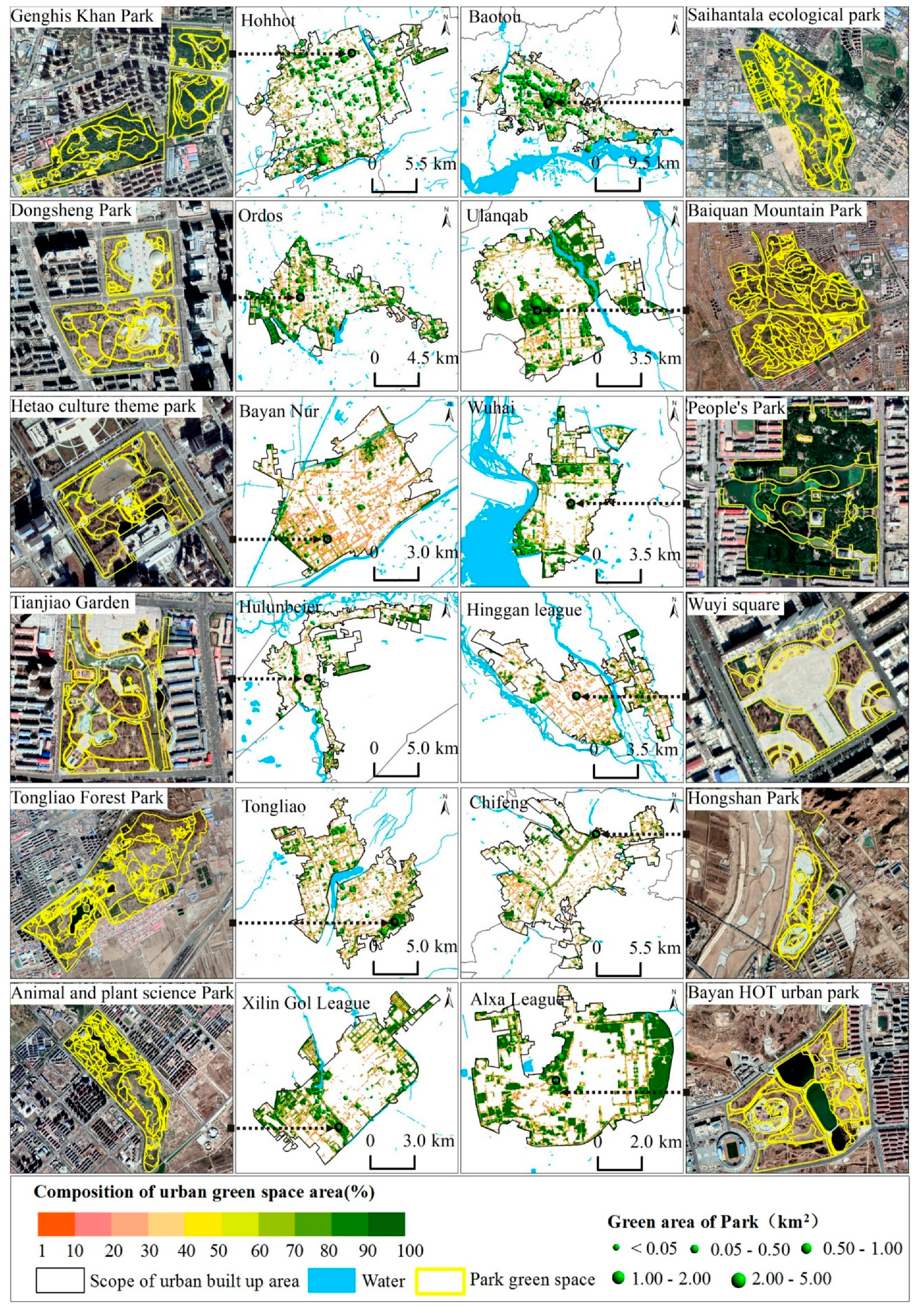
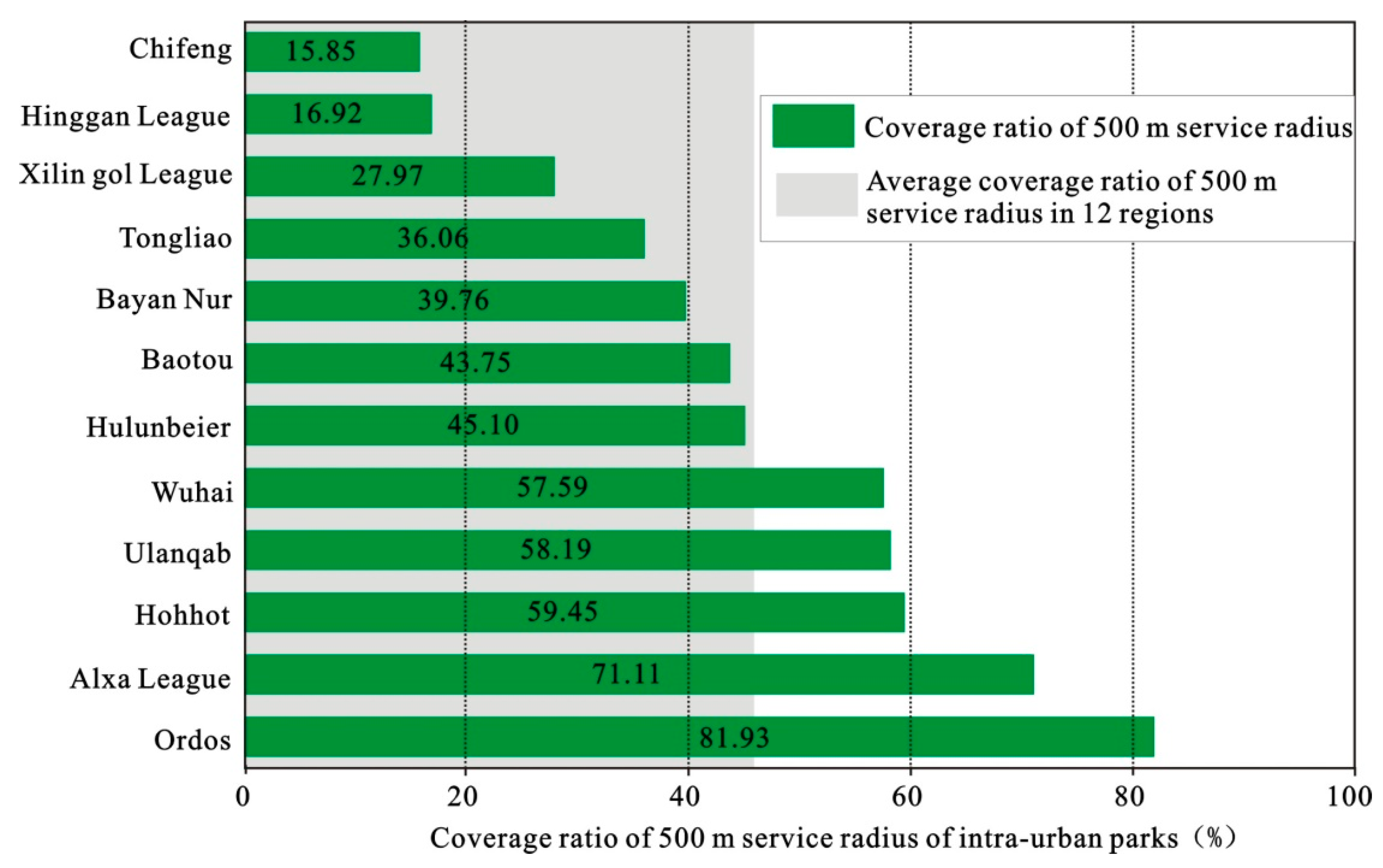
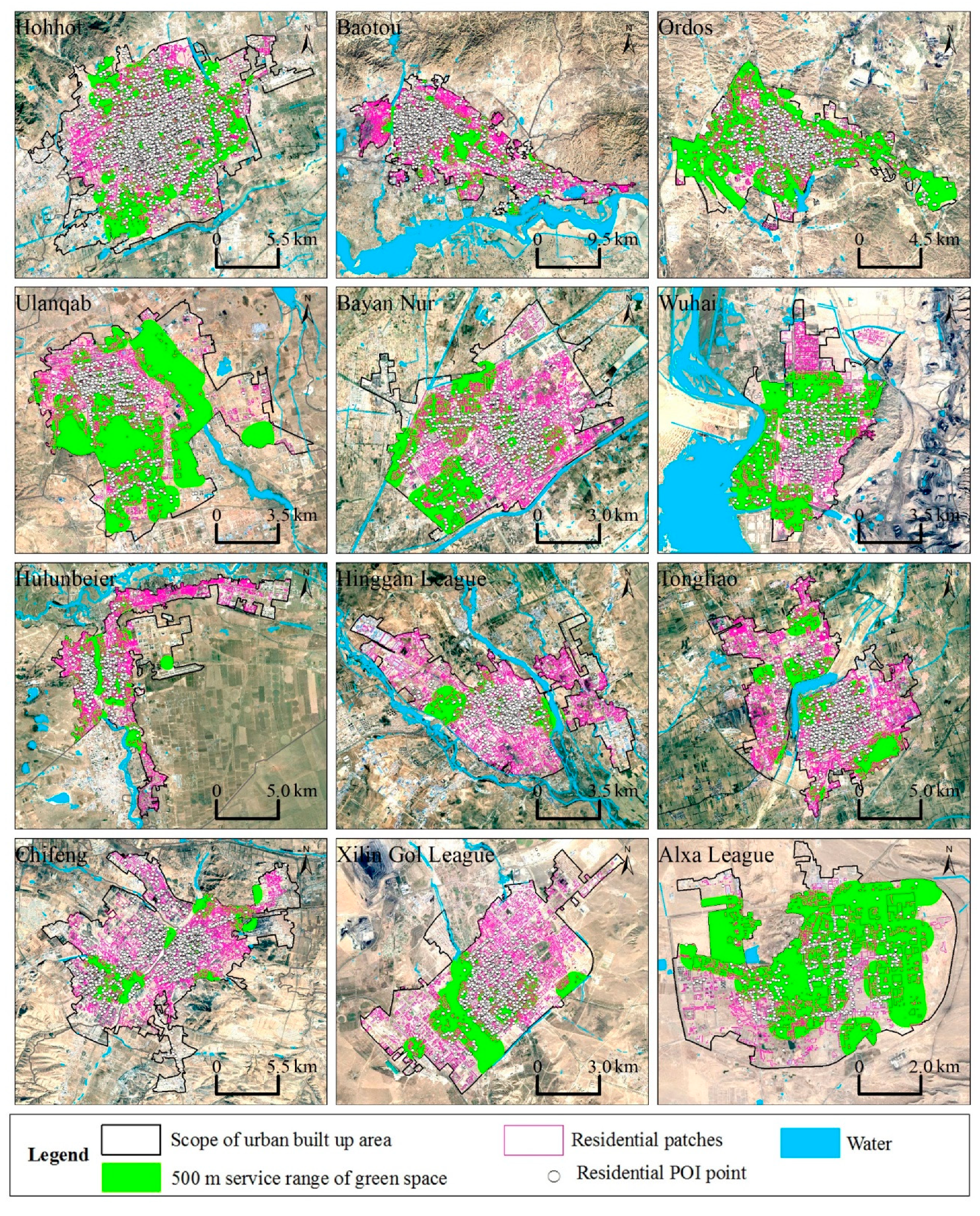
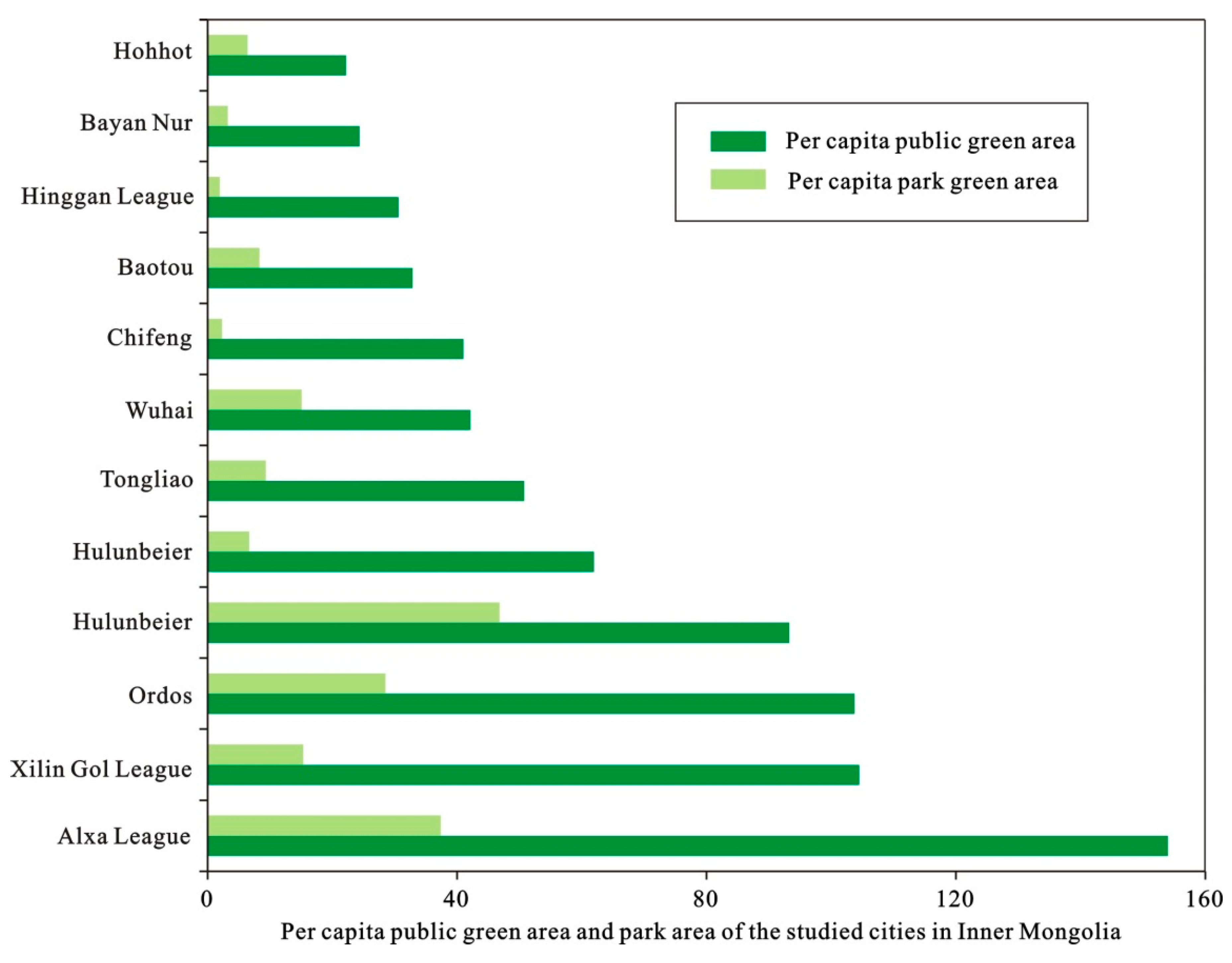

| Data Type | Data Name | Spatial Resolution and Data Type | Data Source |
|---|---|---|---|
| Data for classification | Landsat-8 OLI | The rectified 15-m images | http://glovis.usgs.gov/ |
| Auxiliary data | Administrative boundary of inner Mongolia Plateau; | 1:2,500,000 vector boundary | National Geomatic Center of China |
| Open Street Map (OSM); | 1:100,000 vector boundary | http://www.gadm.org | |
| Data (POI, roads, rivers, etc.); | |||
| City residential population | Statistical data from counties/cities/districts | Statistical bureau of inner Mongolia autonomous region | |
| Validation data | Google imagery | High-resolution images (download level: 18, year: 2019) | http://google-earth.en.softonic.com/ |
| Land use/cover data of China | 1:100,000 city boundary | Institute of Geographic Sciences and Natural Resources Research, Chinese Academy of Sciences |
| City Name | The Number of Sampling Points | City Name | The Number of Sampling Points |
|---|---|---|---|
| Hohhot | 354 | Hulunbuir | 97 |
| Baotou | 354 | Xilin Gol | 87 |
| Tongliao | 124 | Bayannur | 72 |
| Chifeng | 124 | Wuhai | 59 |
| Ordos | 122 | Ulanhot | 59 |
| Ulanqab | 119 | Alxa | 54 |
| Prefecture-Level City | Urban Built-Up Area | Urban Green Space Area | Parks’ Green Space Area | The Ratio of Urban Green Space to Urban Built-Up Area |
|---|---|---|---|---|
| Huhhot | 240.18 | 48.52 | 13.99 | 20.2 |
| Baotou | 306.11 | 79.33 | 20 | 25.92 |
| Ordos | 82.9 | 23.87 | 6.56 | 28.8 |
| Ulanqab | 91.15 | 27.99 | 14.05 | 30.71 |
| Bayannur | 55.01 | 9.4 | 1.24 | 17.09 |
| Wuhai | 45.09 | 12.27 | 4.38 | 27.21 |
| Hulunbuir | 74.18 | 17.17 | 1.85 | 23.14 |
| Hinggan League | 45.35 | 7.9 | 0.5 | 17.43 |
| Tongliao | 88.74 | 20.41 | 3.76 | 23 |
| Chifeng | 100.71 | 17.65 | 0.98 | 17.52 |
| Xilin Gol league | 66.83 | 17.5 | 2.57 | 26.19 |
| Alxa League | 41.62 | 13.39 | 3.25 | 32.17 |
| Total | 1237.87 | 295.4 | 73.14 | 24.03 |
© 2020 by the authors. Licensee MDPI, Basel, Switzerland. This article is an open access article distributed under the terms and conditions of the Creative Commons Attribution (CC BY) license (http://creativecommons.org/licenses/by/4.0/).
Share and Cite
Chi, W.; Jia, J.; Pan, T.; Jin, L.; Bai, X. Multi-Scale Analysis of Green Space for Human Settlement Sustainability in Urban Areas of the Inner Mongolia Plateau, China. Sustainability 2020, 12, 6783. https://doi.org/10.3390/su12176783
Chi W, Jia J, Pan T, Jin L, Bai X. Multi-Scale Analysis of Green Space for Human Settlement Sustainability in Urban Areas of the Inner Mongolia Plateau, China. Sustainability. 2020; 12(17):6783. https://doi.org/10.3390/su12176783
Chicago/Turabian StyleChi, Wenfeng, Jing Jia, Tao Pan, Liang Jin, and Xiulian Bai. 2020. "Multi-Scale Analysis of Green Space for Human Settlement Sustainability in Urban Areas of the Inner Mongolia Plateau, China" Sustainability 12, no. 17: 6783. https://doi.org/10.3390/su12176783






